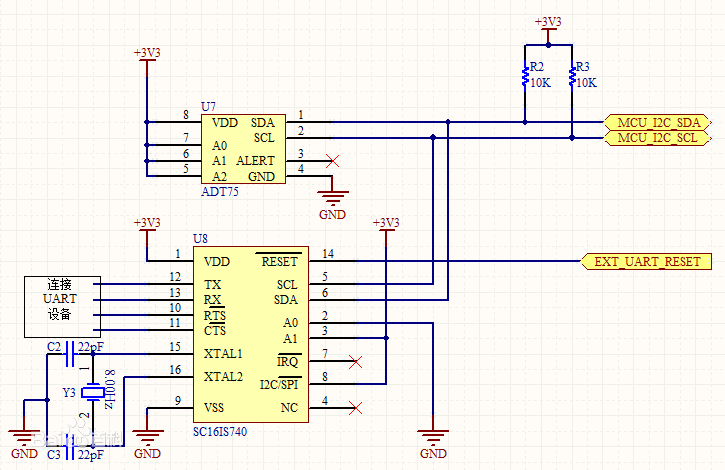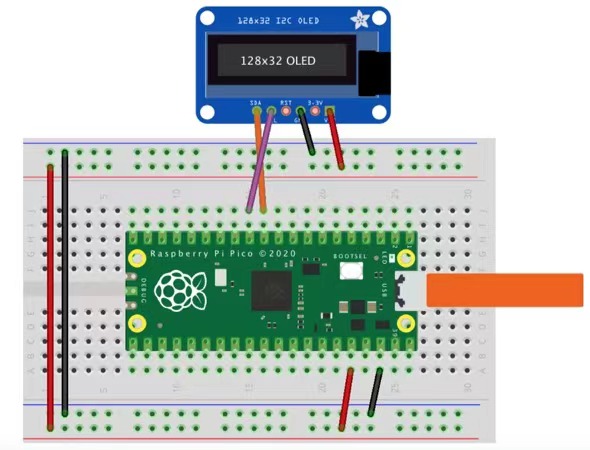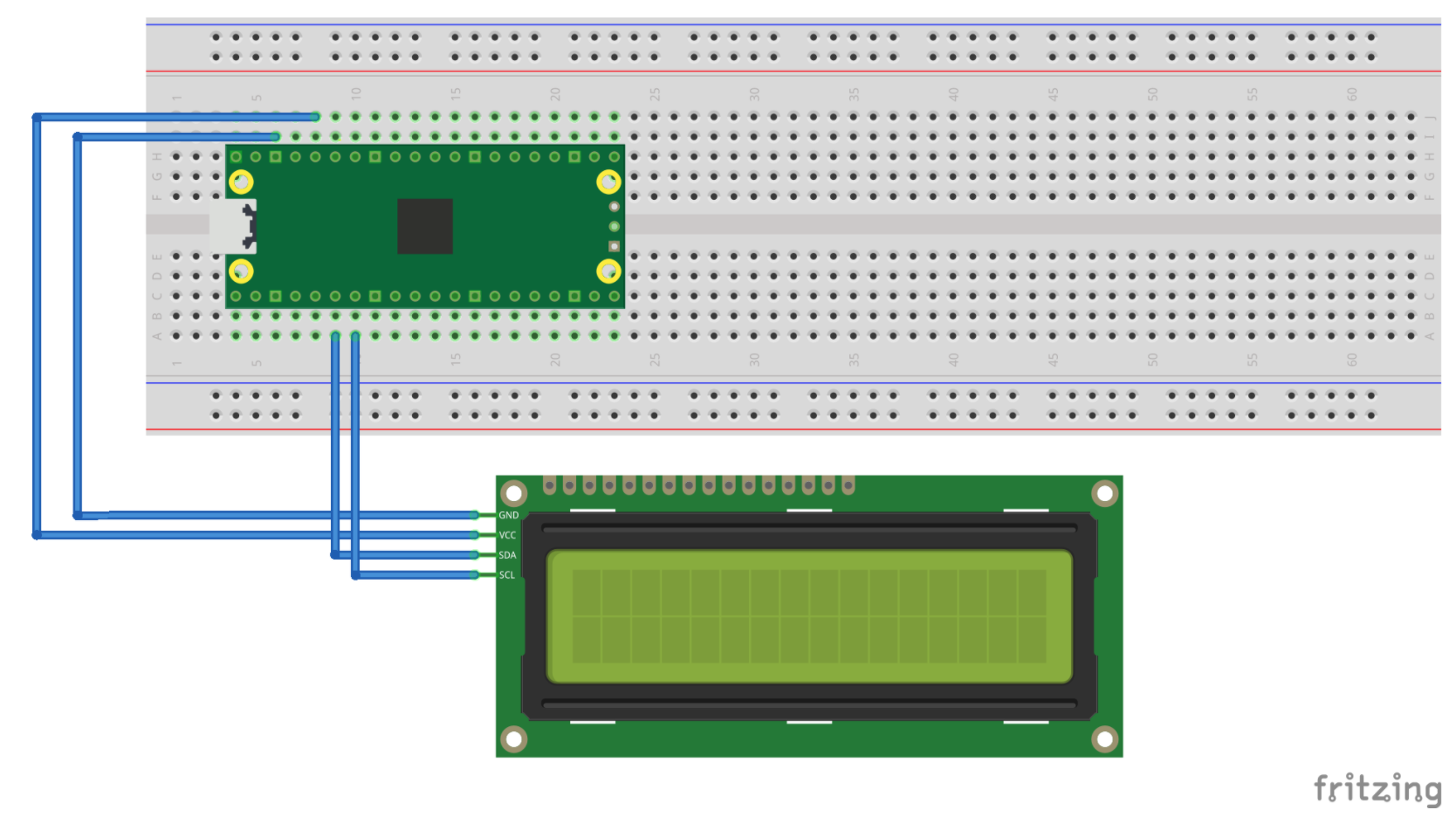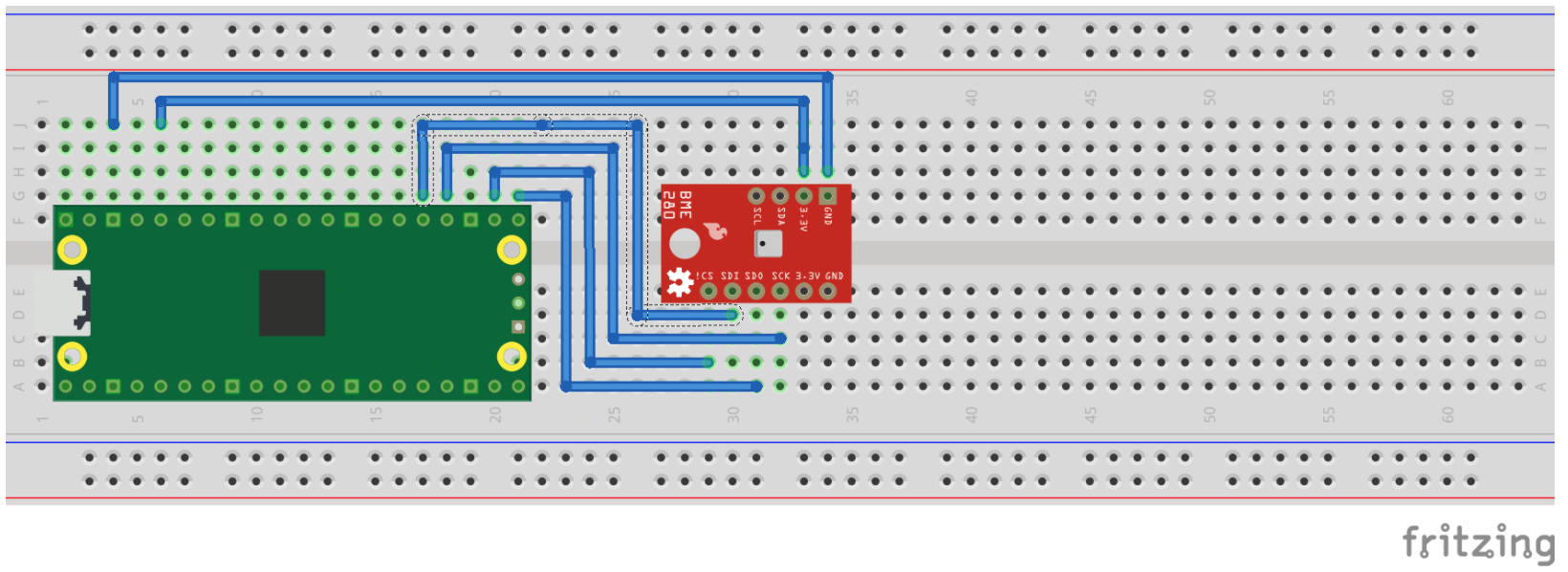I2C
I2C总线是一种简单、双向二线制同步串行总线。SDA(串行数据线)和SCL(串行时钟线)都是双向I/O线,接口电路为开漏输出。需通过上拉电阻接电源VCC.当总线空闲时。两根线都是高电平,连接总线的外同器件都是CMOS器件,输出级也是开漏电路。
MicroPython
我们以OLED屏幕的通信为例。
from machine import I2C, ADC
from sh1106 import SH1106_I2C
import framebuf
WIDTH = 128 # oled display width
HEIGHT = 128 # oled display height
i2c = I2C(0) # Init I2C using I2C0 defaults, SCL=Pin(GP9), SDA=Pin(GP8), freq=400000
print("I2C Address : "+hex(i2c.scan()[0]).upper()) # Display device address
print("I2C Configuration: "+str(i2c)) # Display I2C config
oled = SH1106_I2C(WIDTH, HEIGHT, i2c) # Init oled display
# Raspberry Pi logo as 32x32 bytearray
buffer = bytearray(b"\x00\x00\x00\x00\x00\x00\x00\x00\x00\x00\x00\x00\x00|?\x00\x01\x86@\x80\x01\x01\x80\x80\x01\x11\x88\x80\x01\x05\xa0\x80\x00\x83\xc1\x00\x00C\xe3\x00\x00~\xfc\x00\x00L'\x00\x00\x9c\x11\x00\x00\xbf\xfd\x00\x00\xe1\x87\x00\x01\xc1\x83\x80\x02A\x82@\x02A\x82@\x02\xc1\xc2@\x02\xf6>\xc0\x01\xfc=\x80\x01\x18\x18\x80\x01\x88\x10\x80\x00\x8c!\x00\x00\x87\xf1\x00\x00\x7f\xf6\x00\x008\x1c\x00\x00\x0c \x00\x00\x03\xc0\x00\x00\x00\x00\x00\x00\x00\x00\x00\x00\x00\x00\x00")
# Load the raspberry pi logo into the framebuffer (the image is 32x32)
fb = framebuf.FrameBuffer(buffer, 32, 32, framebuf.MONO_HLSB)
# Clear the oled display in case it has junk on it.
oled.fill(0)
# Blit the image from the framebuffer to the oled display
oled.blit(fb, 96, 0)
# Add some text
oled.text("Raspberry Pi",5,5)
oled.text("Pico",5,15)
# Finally update the oled display so the image & text is displayed
oled.show()C/C++
我们以LCD1602为例。
#include <stdio.h>
#include <string.h>
#include "pico/stdlib.h"
#include "hardware/i2c.h"
#include "pico/binary_info.h"
/* Example code to drive a 16x2 LCD panel via a I2C bridge chip (e.g. PCF8574)
NOTE: The panel must be capable of being driven at 3.3v NOT 5v. The Pico
GPIO (and therefor I2C) cannot be used at 5v.
You will need to use a level shifter on the I2C lines if you want to run the
board at 5v.
Connections on Raspberry Pi Pico board, other boards may vary.
GPIO 4 (pin 6)-> SDA on LCD bridge board
GPIO 5 (pin 7)-> SCL on LCD bridge board
3.3v (pin 36) -> VCC on LCD bridge board
GND (pin 38) -> GND on LCD bridge board
*/
// commands
const int LCD_CLEARDISPLAY = 0x01;
const int LCD_RETURNHOME = 0x02;
const int LCD_ENTRYMODESET = 0x04;
const int LCD_DISPLAYCONTROL = 0x08;
const int LCD_CURSORSHIFT = 0x10;
const int LCD_FUNCTIONSET = 0x20;
const int LCD_SETCGRAMADDR = 0x40;
const int LCD_SETDDRAMADDR = 0x80;
// flags for display entry mode
const int LCD_ENTRYSHIFTINCREMENT = 0x01;
const int LCD_ENTRYLEFT = 0x02;
// flags for display and cursor control
const int LCD_BLINKON = 0x01;
const int LCD_CURSORON = 0x02;
const int LCD_DISPLAYON = 0x04;
// flags for display and cursor shift
const int LCD_MOVERIGHT = 0x04;
const int LCD_DISPLAYMOVE = 0x08;
// flags for function set
const int LCD_5x10DOTS = 0x04;
const int LCD_2LINE = 0x08;
const int LCD_8BITMODE = 0x10;
// flag for backlight control
const int LCD_BACKLIGHT = 0x08;
const int LCD_ENABLE_BIT = 0x04;
#define I2C_PORT i2c0
// By default these LCD display drivers are on bus address 0x27
static int addr = 0x27;
// Modes for lcd_send_byte
#define LCD_CHARACTER 1
#define LCD_COMMAND 0
#define MAX_LINES 2
#define MAX_CHARS 16
/* Quick helper function for single byte transfers */
void i2c_write_byte(uint8_t val) {
i2c_write_blocking(I2C_PORT, addr, &val, 1, false);
}
void lcd_toggle_enable(uint8_t val) {
// Toggle enable pin on LCD display
// We cannot do this too quickly or things don't work
#define DELAY_US 600
sleep_us(DELAY_US);
i2c_write_byte(val | LCD_ENABLE_BIT);
sleep_us(DELAY_US);
i2c_write_byte(val & ~LCD_ENABLE_BIT);
sleep_us(DELAY_US);
}
// The display is sent a byte as two separate nibble transfers
void lcd_send_byte(uint8_t val, int mode) {
uint8_t high = mode | (val & 0xF0) | LCD_BACKLIGHT;
uint8_t low = mode | ((val << 4) & 0xF0) | LCD_BACKLIGHT;
i2c_write_byte(high);
lcd_toggle_enable(high);
i2c_write_byte(low);
lcd_toggle_enable(low);
}
void lcd_clear(void) {
lcd_send_byte(LCD_CLEARDISPLAY, LCD_COMMAND);
}
// go to location on LCD
void lcd_set_cursor(int line, int position) {
int val = (line == 0) ? 0x80 + position : 0xC0 + position;
lcd_send_byte(val, LCD_COMMAND);
}
static void inline lcd_char(char val) {
lcd_send_byte(val, LCD_CHARACTER);
}
void lcd_string(const char *s) {
while (*s) {
lcd_char(*s++);
}
}
void lcd_init() {
lcd_send_byte(0x03, LCD_COMMAND);
lcd_send_byte(0x03, LCD_COMMAND);
lcd_send_byte(0x03, LCD_COMMAND);
lcd_send_byte(0x02, LCD_COMMAND);
lcd_send_byte(LCD_ENTRYMODESET | LCD_ENTRYLEFT, LCD_COMMAND);
lcd_send_byte(LCD_FUNCTIONSET | LCD_2LINE, LCD_COMMAND);
lcd_send_byte(LCD_DISPLAYCONTROL | LCD_DISPLAYON, LCD_COMMAND);
lcd_clear();
}
int main() {
// This example will use I2C0 on GPIO4 (SDA) and GPIO5 (SCL)
i2c_init(I2C_PORT, 100 * 1000);
gpio_set_function(4, GPIO_FUNC_I2C);
gpio_set_function(5, GPIO_FUNC_I2C);
gpio_pull_up(4);
gpio_pull_up(5);
// Make the I2C pins available to picotool
bi_decl( bi_2pins_with_func(4, 5, GPIO_FUNC_I2C));
lcd_init();
static uint8_t *message[] =
{
"RP2040 by", "Raspberry Pi",
"A brand new", "microcontroller",
"Twin core M0", "Full C SDK",
"More power in", "your product",
"More beans", "than Heinz!"
};
while (1) {
for (int m = 0; m < sizeof(message) / sizeof(message[0]); m += MAX_LINES) {
for (int line = 0; line < MAX_LINES; line++) {
lcd_set_cursor(line, (MAX_CHARS / 2) - strlen(message[m + line]) / 2);
lcd_string(message[m + line]);
}
sleep_ms(2000);
lcd_clear();
}
}
return 0;
}CMakeList.txt:
add_executable(lcd_1602_i2c
lcd_1602_i2c.c
)
# Pull in our (to be renamed) simple get you started dependencies
target_link_libraries(lcd_1602_i2c pico_stdlib hardware_i2c)
# create map/bin/hex file etc.
pico_add_extra_outputs(lcd_1602_i2c)
# add url via pico_set_program_url
example_auto_set_url(lcd_1602_i2c)SPI
SPI是串行外设接口(Serial Peripheral Interface)的缩写。是 Motorola 公司推出的一 种同步串行接口技术,是一种高速的,全双工,同步的通信总线。主要应用在EEPROM、Flash、实时时钟(RTC)、数模转换器(ADC)、网络控制器、MCU、数字信号处理器(DSP)以及数字信号解码器之间。
MicroPython
from machine import SPI
spi = SPI(0)
spi = SPI(0, 100_000)
spi = SPI(0, 100_000, polarity=1, phase=1)
spi.write('test')
spi.read(5)
buf = bytearray(3)
spi.write_readinto('out', buf)C/C++
以bme280温度压力传感器为例。
#include <stdio.h>
#include <string.h>
#include "pico/stdlib.h"
#include "hardware/spi.h"
#define PIN_MISO 16
#define PIN_CS 17
#define PIN_SCK 18
#define PIN_MOSI 19
#define SPI_PORT spi0
#define READ_BIT 0x80
int32_t t_fine;
uint16_t dig_T1;
int16_t dig_T2, dig_T3;
uint16_t dig_P1;
int16_t dig_P2, dig_P3, dig_P4, dig_P5, dig_P6, dig_P7, dig_P8, dig_P9;
uint8_t dig_H1, dig_H3;
int8_t dig_H6;
int16_t dig_H2, dig_H4, dig_H5;
/* The following compensation functions are required to convert from the raw ADC
data from the chip to something usable. Each chip has a different set of
compensation parameters stored on the chip at point of manufacture, which are
read from the chip at startup and used inthese routines.
*/
int32_t compensate_temp(int32_t adc_T) {
int32_t var1, var2, T;
var1 = ((((adc_T >> 3) - ((int32_t) dig_T1 << 1))) * ((int32_t) dig_T2)) >> 11;
var2 = (((((adc_T >> 4) - ((int32_t) dig_T1)) * ((adc_T >> 4) - ((int32_t) dig_T1))) >> 12) * ((int32_t) dig_T3))
>> 14;
t_fine = var1 + var2;
T = (t_fine * 5 + 128) >> 8;
return T;
}
uint32_t compensate_pressure(int32_t adc_P) {
int32_t var1, var2;
uint32_t p;
var1 = (((int32_t) t_fine) >> 1) - (int32_t) 64000;
var2 = (((var1 >> 2) * (var1 >> 2)) >> 11) * ((int32_t) dig_P6);
var2 = var2 + ((var1 * ((int32_t) dig_P5)) << 1);
var2 = (var2 >> 2) + (((int32_t) dig_P4) << 16);
var1 = (((dig_P3 * (((var1 >> 2) * (var1 >> 2)) >> 13)) >> 3) + ((((int32_t) dig_P2) * var1) >> 1)) >> 18;
var1 = ((((32768 + var1)) * ((int32_t) dig_P1)) >> 15);
if (var1 == 0)
return 0;
p = (((uint32_t) (((int32_t) 1048576) - adc_P) - (var2 >> 12))) * 3125;
if (p < 0x80000000)
p = (p << 1) / ((uint32_t) var1);
else
p = (p / (uint32_t) var1) * 2;
var1 = (((int32_t) dig_P9) * ((int32_t) (((p >> 3) * (p >> 3)) >> 13))) >> 12;
var2 = (((int32_t) (p >> 2)) * ((int32_t) dig_P8)) >> 13;
p = (uint32_t) ((int32_t) p + ((var1 + var2 + dig_P7) >> 4));
return p;
}
uint32_t compensate_humidity(int32_t adc_H) {
int32_t v_x1_u32r;
v_x1_u32r = (t_fine - ((int32_t) 76800));
v_x1_u32r = (((((adc_H << 14) - (((int32_t) dig_H4) << 20) - (((int32_t) dig_H5) * v_x1_u32r)) +
((int32_t) 16384)) >> 15) * (((((((v_x1_u32r * ((int32_t) dig_H6)) >> 10) * (((v_x1_u32r *
((int32_t) dig_H3))
>> 11) + ((int32_t) 32768))) >> 10) + ((int32_t) 2097152)) *
((int32_t) dig_H2) + 8192) >> 14));
v_x1_u32r = (v_x1_u32r - (((((v_x1_u32r >> 15) * (v_x1_u32r >> 15)) >> 7) * ((int32_t) dig_H1)) >> 4));
v_x1_u32r = (v_x1_u32r < 0 ? 0 : v_x1_u32r);
v_x1_u32r = (v_x1_u32r > 419430400 ? 419430400 : v_x1_u32r);
return (uint32_t) (v_x1_u32r >> 12);
}
static inline void cs_select() {
asm volatile("nop \n nop \n nop");
gpio_put(PIN_CS, 0); // Active low
asm volatile("nop \n nop \n nop");
}
static inline void cs_deselect() {
asm volatile("nop \n nop \n nop");
gpio_put(PIN_CS, 1);
asm volatile("nop \n nop \n nop");
}
static void write_register(uint8_t reg, uint8_t data) {
uint8_t buf[2];
buf[0] = reg & 0x7f; // remove read bit as this is a write
buf[1] = data;
cs_select();
spi_write_blocking(SPI_PORT, buf, 2);
cs_deselect();
sleep_ms(10);
}
static void read_registers(uint8_t reg, uint8_t *buf, uint16_t len) {
// For this particular device, we send the device the register we want to read
// first, then subsequently read from the device. The register is auto incrementing
// so we don't need to keep sending the register we want, just the first.
reg |= READ_BIT;
cs_select();
spi_write_blocking(SPI_PORT, ®, 1);
sleep_ms(10);
spi_read_blocking(SPI_PORT, 0, buf, len);
cs_deselect();
sleep_ms(10);
}
/* This function reads the manufacturing assigned compensation parameters from the device */
void read_compensation_parameters() {
uint8_t buffer[26];
read_registers(0x88, buffer, 24);
dig_T1 = buffer[0] | (buffer[1] << 8);
dig_T2 = buffer[2] | (buffer[3] << 8);
dig_T3 = buffer[4] | (buffer[5] << 8);
dig_P1 = buffer[6] | (buffer[7] << 8);
dig_P2 = buffer[8] | (buffer[9] << 8);
dig_P3 = buffer[10] | (buffer[11] << 8);
dig_P4 = buffer[12] | (buffer[13] << 8);
dig_P5 = buffer[14] | (buffer[15] << 8);
dig_P6 = buffer[16] | (buffer[17] << 8);
dig_P7 = buffer[18] | (buffer[19] << 8);
dig_P8 = buffer[20] | (buffer[21] << 8);
dig_P9 = buffer[22] | (buffer[23] << 8);
dig_H1 = buffer[25];
read_registers(0xE1, buffer, 8);
dig_H2 = buffer[0] | (buffer[1] << 8);
dig_H3 = (int8_t) buffer[2];
dig_H4 = buffer[3] << 4 | (buffer[4] & 0xf);
dig_H5 = (buffer[5] >> 4) | (buffer[6] << 4);
dig_H6 = (int8_t) buffer[7];
}
static void bme280_read_raw(int32_t *humidity, int32_t *pressure, int32_t *temperature) {
uint8_t buffer[8];
read_registers(0xF7, buffer, 8);
*pressure = ((uint32_t) buffer[0] << 12) | ((uint32_t) buffer[1] << 4) | (buffer[2] >> 4);
*temperature = ((uint32_t) buffer[3] << 12) | ((uint32_t) buffer[4] << 4) | (buffer[5] >> 4);
*humidity = (uint32_t) buffer[6] << 8 | buffer[7];
}
int main() {
stdio_init_all();
printf("Hello, bme280! Reading raw data from registers via SPI...\n");
// This example will use SPI0 at 0.5MHz.
spi_init(SPI_PORT, 500 * 1000);
gpio_set_function(PIN_MISO, GPIO_FUNC_SPI);
gpio_set_function(PIN_SCK, GPIO_FUNC_SPI);
gpio_set_function(PIN_MOSI, GPIO_FUNC_SPI);
// Chip select is active-low, so we'll initialise it to a driven-high state
gpio_init(PIN_CS);
gpio_set_dir(PIN_CS, GPIO_OUT);
gpio_put(PIN_CS, 1);
// See if SPI is working - interrograte the device for its I2C ID number, should be 0x60
uint8_t id;
read_registers(0xD0, &id, 1);
printf("Chip ID is 0x%x\n", id);
read_compensation_parameters();
write_register(0xF2, 0x1); // Humidity oversampling register - going for x1
write_register(0xF4, 0x27);// Set rest of oversampling modes and run mode to normal
int32_t humidity, pressure, temperature;
while (1) {
bme280_read_raw(&humidity, &pressure, &temperature);
// These are the raw numbers from the chip, so we need to run through the
// compensations to get human understandable numbers
pressure = compensate_pressure(pressure);
temperature = compensate_temp(temperature);
humidity = compensate_humidity(humidity);
printf("Humidity = %.2f%%\n", humidity / 1024.0);
printf("Pressure = %dPa\n", pressure);
printf("Temp. = %.2fC\n", temperature / 100.0);
sleep_ms(1000);
}
return 0;
}CMakeList.txt:
add_executable(bme280_spi
bme280_spi.c
)
# Pull in our (to be renamed) simple get you started dependencies
target_link_libraries(bme280_spi pico_stdlib hardware_spi)
# create map/bin/hex file etc.
pico_add_extra_outputs(bme280_spi)
# add url via pico_set_program_url
example_auto_set_url(bme280_spi)本文转自:Github
作者:zihan987
推荐阅读
- 阿chai带你学Raspberry Pi Pico基础篇:IO口的使用/UART通信/中断/定时器
- 阿chai带你学Raspberry Pi Pico:环境搭建与简介
- 华为A910芯片+MindSpore与2080Ti/P100/T4+PyTorch实测对比
更多嵌入式AI技术相关内容请关注嵌入式AI专栏。







